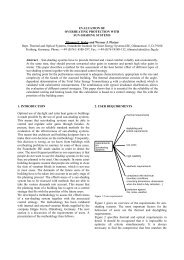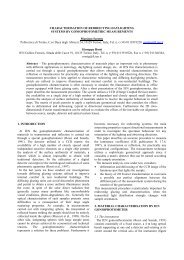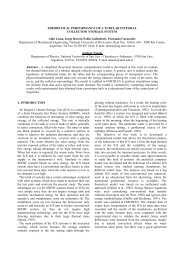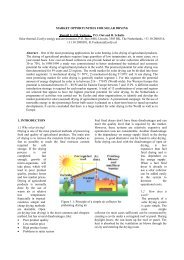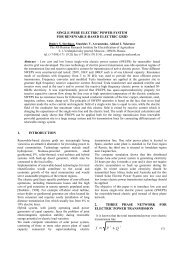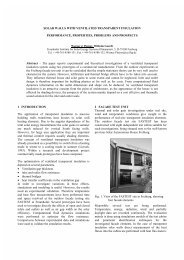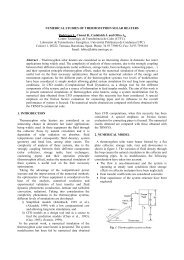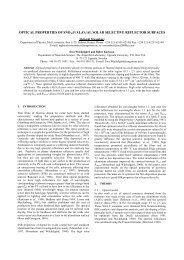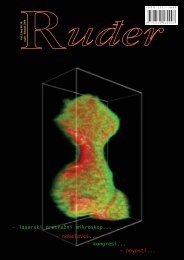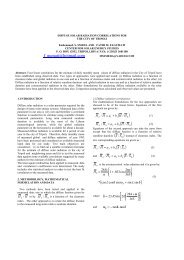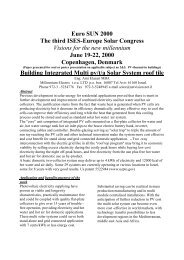SURFACE ANALYSIS OF MONO-CRYSTALLINE SILICON SOLAR ...
SURFACE ANALYSIS OF MONO-CRYSTALLINE SILICON SOLAR ...
SURFACE ANALYSIS OF MONO-CRYSTALLINE SILICON SOLAR ...
Create successful ePaper yourself
Turn your PDF publications into a flip-book with our unique Google optimized e-Paper software.
Table 1. Surface atomic concentration, and some ratios between them, for the different samples.Sample 1 Sample 2 Sample 3 Sample 4 Sample 5 Sample 6a Sample 6m%Ti --- --- --- 19.8 20.9 22.0 0.0%Si 59.8 32.0 29.1 2.4 0.5 0.6 4.8%O 29.8 59.2 63.6 50.3 54.9 57.8 22.3%C 9.6 4.3 5.4 27.2 20.2 21.1 33.7%P --- 4.5 1.9 0.3 3.6 1.1 0.0%Ag --- --- --- --- --- 0.2 15.3%Pb --- --- --- --- --- 0.3 7.0%Cl --- --- --- --- --- 0.0 16.9Ti/O --- --- --- 0.394 0.381 0.381 ---Si/O 2.007 0.541 0.458 0.048 0.009 0.010 ---Si/Ti --- --- --- 0.121 0.024 0.027 ---for sample 1 to 3 is Si and for sample 4 to 6a is Ti. Figure 4shows the Lorentzian-Gaussian type fitting curves (continuesline) to the recorded photoelectron spectra (points) due to thedifferent chemical environment of each element. In the followingwe will discuss the XPS results for each sample surface.4. DISCUSSION4.1 Sample 1 (the textured silicon surface)For sample 1, as can be seen in Figure 3 and Figure 4, we candistinguish two well separated Si2p peaks. The one at 99.4 eVin binding energy (BE) corresponds to the p-type silicon bulk(Hedman et. al., 1972) and the other at 103.2 eV to silicon oxide(Moulder, 1998), the latter indicating that the uppermost atomicmonolayer of the silicon wafer has been oxidized to SiO 2 due tobeing in contact with the atmosphere. Boron has not beendetected by XPS since its atomic concentration is below theXPS detection limit. Also about 10% of carbon (see Table 1 andFigure 3) has been detected at the silicon surface. A few min of 4KeV Ar + sputtering eliminates this amount of carbon showingthat it is a surface contamination due to the exposure of thesilicon wafer to air. In Figure 4, the C1s signal can be seendeconvoluted into different contributions. About 23% of thesignal is due to carbon in various environments with O and H.Fitting has been done with bands due to contributions of carbonoxygenfunctional groups (Desimoni et al., 1990). But the mainpeak of the C1s signal is due to C-C bindings givingcontributions at 284.6 eV in BE. Here, we would like to pointout that the presence of carbon at the silicon wafer surface couldbe an critical point for the further manufacturing steps,especially when heating processes are involved and the amountof carbon in spite of being desorbed and burned to CO 2 couldalso diffuse into the silicon bulk crystal structure and hencegenerate centers of recombination for charge carriers.4.2 Sample 2 (after phosphor diffusion)Besides the elements observed in sample 1, phosphor isdetected at the surface of sample 2 (see Table 1). Thisdemonstrates that P stays in excess at the wafer surface sincethe P doping concentration making the p-n junction in the siliconbulk is below XPS detection limit. Figure 4 shows the P 2p peakdeconvoluted into P 2p 3/2 and P 2p 1/2 contributions. The P 2p 3/2peak is found at 134.6 eV, a very high value in BE compared tovalues documented in the literature (Moulder et al., 1992). Thisshows that P at the waver surface is found in a veryelectronegative surrounding. However, Chlorine, an elementinvolved in the process of P diffusion (phosphor oxi-chloride ina nitrogen flux is used), has not been detected at the wafersurface. Only a very small N 1s signal has been detected yieldinga atomic ratio of N/Si=0.0089. On the other hand, the Si 2psignal has changed showing only one peak at 103.7 eV (see Fig.3) to be entirely due to SiO 2 which has been formed at the wafersurface during the P diffusion process at about 1000ºC.Correspondingly the amount of oxygen has increased to thedouble compared to sample 1 yielding a atomic ratio ofSi/O=0.54 near to 0.5 for SiO2. Also the


